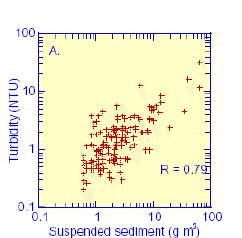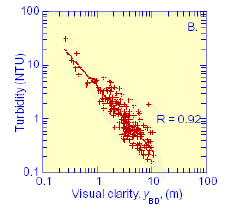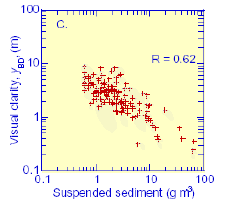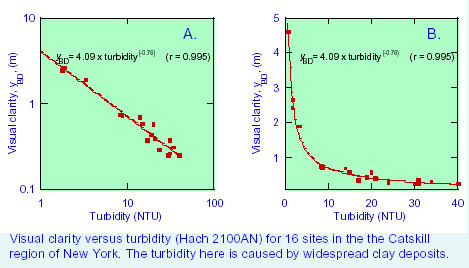Excerpted from “If Water Clarity is the Issue, Why Not Measure It?”*
D.G. Smith, Department of Environmental Protection, Bureau of Water Supply, 465 Columbus Avenue, Valhalla, NY 10595
and
R.J. Davies-Colley, National Institute of Water and Atmospheric Research Ltd. (NIWA), PO Box 11-115, Hamilton, New Zealand
* Poster presented at the National Water Quality Monitoring Council Conference, Madison, Wisconsin, May 2002.
Introduction
Suspended sediment causes many adverse aquatic impacts, including:
- transport of other pollutants
- benthic smothering
- costly treatment of water supplies
Often, the worst impact is optical—caused by decreased light transmission through water. This has two main effects:
- reduced light penetration for photosynthesis
- reduced visual range of sighted organisms, including people
Unfortunately, concepts of suspended sediment concentration (SSC), nephelometric turbidity, and visual water clarity are poorly understood.
This paper is based on a recent review of the topic (Davies-Colley & Smith, 2001) and emphasizes the use of visual water clarity measurement.
Visual Water Clarity
Visual clarity has been traditionally measured in lakes using a Secchi disc. But the conventional Secchi disc measurement has several problems:
- as a vertical measurement, it needs relatively deep water
- it has no accepted protocol
- it is dependent on lighting conditions
The All-Black Disc
A better measure of visual clarity is obtained using an all-black disk viewed horizontally. A horizontal black disc measurement has several advantages:
- it can be performed in very shallow waters
- it is independent of lighting conditions (being black, its orientation relative to the sun is unimportant)
- it is very simply related to beam attenuation coefficient (a fundamental optical property)
- it can be used in lentic situations (lakes and ponds) as well as moving water
 |
 |
Turbidity
Turbidity (water cloudiness) is usually measured in the laboratory (units: NTU) and is often, uncritically, taken to be equivalent to visual clarity. There are several problems with turbidity measurement, for instance:
- different instruments may produce different numbers
- it is an arbitrary measurement, usually measured relative to a formazin standard
- it is not a ‘proper’ scientific measure
- turbidity is not uniquely related to visual clarity or SSC
We discourage its use as a general environmental measurement.
Inter-relationships Between Turbidity, Suspended Sediment Concentration and Visual Clarity
These three measurements are only broadly correlated, although the optical variables (visual clarity and turbidity) are more closely related to each other than SSC. However, the relationships are inadequate for general use and for useful predictive purposes. Also, waters at different sites having the same turbidity can have widely different visual clarities.
 |
 |
 |
| Mutual relationships in 97 New Zealand rivers at base flow (Hach 2100A nephelometer). | ||
Sometimes useful, close relationships are found in waters having particles of similar optical character—these are usually site-specific.
SSC is not relevant when the impacts of concern are optical. Turbidity is not immediately relevant in environmental studies because it needs to be calibrated to visual clarity at different sites. Visual clarity has most environmental relevance because it is a direct measure of an optical attribute that strongly affects aquatic habitat and human uses of waters.
Visual clarity measurement is highly suitable for general optical environmental standards, unlike SSC and turbidity.
Conclusions
If the effect of interest of suspended sediment is optical, and related to visual sighting range, then measure visual clarity using the horizontal black disk technique.
Visual clarity:
- is a true scientific measurement
- has immediate environmental relevance
- is readily understood
- is not particularly subjective
- can be measured with better precision than SSC and turbidity
- is more relevant than SSC and turbidity
- should be used in environmental standards dealing with water optics
References
Davies-Colley, R.J. and D.G Smith, 2001. Turbidity, Suspended Sediment, and Water Clarity: A Review. Journal of the American Water Resources Association 37: 1085-1101.
| Attribute | Cost | Precision(typical standard error) | Sample size & storage | Continuous monitoring? | Environmental relevance |
| Suspended sediment concentration (SSC) | $23/sample | 10% | 100 mg residue*(sample fairly table if chilled, dark) | No (needs laboratory) | Relevant to sediment yields and benthic effects of sedimentation. Less relevant to optical impacts. |
| Turbidity | $5/sample | 10% | < 100 mL(unstable-keep chilled, dark, and measure in less than 24 hours) | Yes(turbidity monitors) | Measurement is relative to arbitrary standards. Requires calibration (e.g., to suspended solids. Indirectly relevant to solids or visual clarity). |
| Visual clarity, alternatively, beam attenuation coefficient) | $4/observation | 4% | Not applicable (usually done in situ) | Yes, as beam transmittance | Relevant to aesthetic quality of water and habitat for sighted aquatic animals. |
*Requires 10 liter sample at 10 g m-3 for high precision. Volumes may get prohibitively large in clearer waters.


